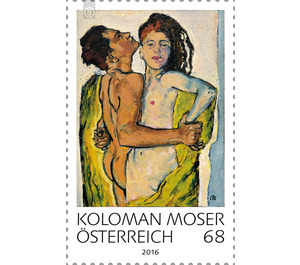Modern Art - Austria / II. Republic of Austria 2016 - 68 Euro Cent
Theme: Art & Culture
| Country | Austria / II. Republic of Austria |
| Issue Date | 2016 |
| Face Value | 68.00 |
| Edition Issued | 260,000 |
| Printing Type | offset |
| Stamp Type | Commemorative |
| Item Type | Stamp |
| Chronological Issue Number | 2620 |
| Chronological Chapter | OOS-OE2 |
| SID | 679354 |
| In 67 Wishlists | |
"Thousand artist" was the name given to Kolo Moser, born in Vienna in 1868, since he worked in so many different disciplines of the arts. Whether painting or crafts, whether the production of furniture, jewelry, vases or glasses - according to the idea of Gesamtkunstwerk, whose pioneer he was, his work penetrated many areas, and Moser became a key figure for the rise of Austrian art in the 20th century. After graduating, he joined the Siebenerclub, a nucleus of the Vienna Secession - when it was founded in 1897, he became one of the most important actors on the contemporary art parquet. The Secession building, which Moser co-designed, is still standing near Karlsplatz today and was known as the "Golden Krauthappel". But he also worked away from the Secession and strove for his own, which he finally found in the Wiener Werkstätte. The aim of this was to combine various forms of craftsmanship and let the craftsman as well as the designing artist apply. In addition, it was "based on the purpose, the usability is our first condition, our strength should be in good conditions and in good material treatment," it said in the program of the Wiener Werkstätte. Simple and functional, but first-class should be everything that was produced there. "Realizing a party dress" was what Koloman Moser was all about. Entire home furnishings were created by the Wiener Werkstätte, including the furnishings of the fashion salon Flöge by Emilie Flöge, Gustav Klimt's Muse, and the establishment of the Sanatorium in Purkersdorf. In addition to interiors based on Moser's designs, furniture, jewelery, leather and metalwork, toys and book covers were also produced. After leaving the Wiener Werkstätte Koloman Moser concentrated strongly on painting. He died like Klimt, Schiele and Otto Wagner in 1918. He had decisively influenced the art of his time. The oil painting, which serves as a model for the commemorative stamp from the series "Modern Art in Austria", was created around 1913 and comes from the Austrian artist, who also designed Postwertzeichen himself.


